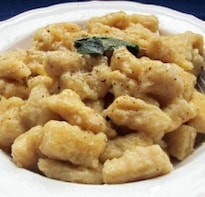Potatoes
Of course, as soon as I start looking at recipes, I realise this is going to be a little more difficult than perfecting mash or jacket potatoes - because, where food's concerned, all Italians seem to agree on is that it's very, very important. Locatelli's Made in Italy and Other Stories assures me that I need "very starchy potatoes", while Giuliano Hazan reckons "the secret to making good gnocchi is using the right potato, which should be neither too waxy nor too starchy".Advertisement
Cooking the potatoes
Most people boil their potatoes for gnocchi, but, as Hartnett says in her book Cucina, "the trick is to keep the potatoes dry so that the gnocchi are fluffy and melt in the mouth". Locatelli puts the oven on low, so he can dry the cooked potatoes out before use, but a better idea comes from Hartnett, who bakes the potatoes on a bed of rock salt (presumably to absorb any moisture). Although you lose a little more potato flesh when you peel them, it's worth it, both for the drier results and, more noticeably in my opinion, their intensely potatoey flavour.Everyone agrees it's important to make the dough while the potatoes are still hot, or you risk someone actually having to chew their dinner - a deeply shameful experience for any aspiring gnocchi master. This, of course, means that you will have to be brave, because the phrase hot potato didn't come about by accident; insulated by their skins, it's like juggling rocks thrown straight from the sun. But would a nonna complain? No she would not.Once they're peeled, use a potato ricer if you have one, or push the cooked potato through a fine sieve from a little height to get some air into it, as Ursula Ferrigno recommends.Advertisement
Flour
The dough is bound together with flour, and as little as possible according to Del Conte, who claims in the Classic Food of Northern Italy that in Piedmont "the best gnocchi makers manage only to use 100g flour to 1kg potatoes!" I have more modest ambitions, and if Locatelli's ratio of 320g flour to 1kg spuds is good enough for the Michelin inspectors, then it's certainly good enough for me.Del Conte and Ferrigno's Complete Italian Cookery Course suggest using Italian 00 flour, which is the very fine stuff called for in pasta recipes. I can't tell the difference in the finished dishes, and given the relative prices, I suspect a respectably thrifty Italian would stick with the plain stuff.Seasoning that flour is obviously a good thing, gnocchi having a dangerous tendency to blandness, but Hartnett adds a pinch of nutmeg as well. I'm a sucker for its sweet, peppery flavour, as has been noted with disapproval by many of you before, and again, I think it works really well with the rich, buttery sauces that gnocchi tends to be paired with, but feel free to leave it out if you hate the stuff.Eggs
I've been saving the most contentious issue until almost last. As the Rome-based blog Rachel Eats puts it, with gnocchi, "to add eggs or not to add eggs: that is the question". Del Conte says that, "broadly speaking, gnocchi with eggs are made in Veneto", while in Piedmont they don't approve. Hazan, born in Emilia-Romagna, is very much in the west-coast camp, announcing that eggs are not a traditional ingredient, but a crutch to make up for an inferior potato - or indeed, an inferior chef. Her recipe uses only potato, flour and seasoning, as does Del Conte's. I'm proud to say that they held together fine - but perhaps it's my palate that's inferior, because I preferred the more robust egg-bound versions produced by Locatelli, Hartnett and Ferrigno. They are also, and perhaps not coincidentally, far easier to make.Advertisement
The kneading and cooking
Locatelli's right not to overwork the dough or you'll begin to develop the gluten in the flour, leading, yet again, to fatally chewy results - I find it easiest to mix everything straight on to the work surface as Hartnett suggests.Make sure everything's lightly floured, from your hands to the tray on which you arrange the shaped gnocchi: although you don't want to add too much excess flour to the dough, clumping is a crime even more heinous than chewiness. To this end, stirring the gnocchi in the pan, Locatelli style, is advisable - it also means you can keep an eagle eye on them, ready for the first one to pop up and tell you it's ready. And if you're after a recipe for ragù ...The perfect gnocchi
1kg large Désirée potatoes, all roughly the same sizeRock salt
350g plain flour
½ tsp fine salt
Pinch of nutmeg (optional)
2 small eggs, beaten
Advertisement
In Picture: Perfect gnocchi.
For the latest food news, health tips and recipes, like us on Facebook or follow us on Twitter and YouTube.
Advertisement
